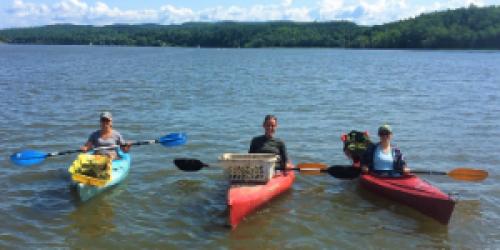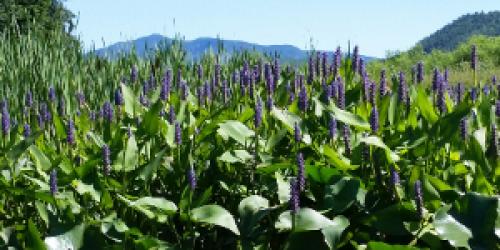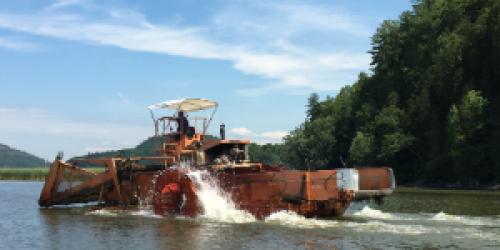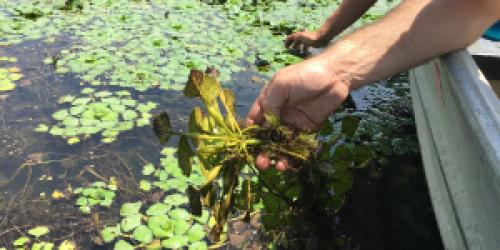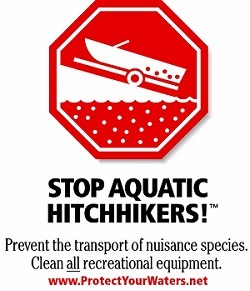The Vermont Aquatic Invasive Species Program, or Aquatic Nuisance Control Program as stated in the Vermont State Legislature (10 V.S.A. 1453), coordinates management activities associated with both aquatic invasive and nuisance species; works with local, state, and federal partners to obtain and provide funds for control projects; and provides education and outreach to reduce the threat and spread of aquatic invasive species (AIS). The Aquatic Nuisance Control statute also provides the framework for regulations on aquatic nuisance control management activities and permits (10. V.S.A. 1455). Highlights of the many activities that the program staff and technicians annually complete can be found in the 2020 Aquatic Invasive Species Annual Update. AIS population information, management actions, and spread prevention efforts can also be viewed geographically on the Aquatic Invasive Species Program Map.
Aquatic Invasive Species Program
Aquatic Invasive or Aquatic Nuisance Species?
Aquatic invasive species are non-native species whose introduction can cause harm to the environment, economy, and even human health. Aquatic nuisance species are defined in the Aquatic Nuisance Control statute (10 V.S.A. 1452) as undesirable or excessive substances or populations that interfere with the recreational potential or aquatic habitat of a body of water, including rooted aquatic plants and animal and algal populations. All aquatic invasive species are considered aquatic nuisance species, but aquatic nuisance species may be also be native. Below are Vermont's high-priority aquatic invasive species. The complete list of aquatic invaders threatening Vermont can be found in the Gallery of Invaders.
A Few of Vermont Aquatic Invasive Species
What is being done in Vermont?
- Vermont DEC provides educational materials including pamphlets and newsletters, slide shows, identification posters, public access signage, and provides technical assistance to towns, waterbody associations, and other interested parties.
- Monitoring efforts designed to detect new populations of invasive plants and animals are ongoing by governmental entities and by the Vermont Invasive Patrollers (VIP) Program, which is a citizen-based early detection program. VIPs are volunteers who are trained to search water bodies for new infestations.
- Funding for aquatic invasive species management projects is available from Vermont DEC and from outside sources.
- Various control efforts for invasive species have been implemented and are continuing across Vermont. Please see our guide for aquatic plant management to learn about management options for nuisance vegetation growth.
- Spread prevention projects designed at containing further AIS spread are ongoing. The Vermont Public Access Greeter Program helps to educate boaters and provide courtesy watercraft inspections to prevent invasive plants and animals from spreading from one waterbody to another.
- There are multiple Vermont state laws that restrict invasive species transport and are aimed to stop new introductions.
Aquatic Invasive Species Map
The AIS Map is a visual representation of aquatic invasive species population data, associated management actions, and spread prevention efforts statewide. This map can be used to filter based on the following layers: Public Access Greeter Programs, Vermont Invasive Patroller programs, AIS signage and public access information, AIS control efforts, and AIS status by waterbody. The AIS status by waterbody layer indicates known populations of high-profile AIS, and those waters where no AIS has been confirmed by DEC staff.
Before moving boats between waterbodies:
- CLEAN off any mud, plants, and animals from boat, trailer, motor and other equipment. Discard removed material in a trash receptacle or on high, dry ground where there is no danger of them washing into any water body.
- DRAIN all water from boat, boat engine, and other equipment away from the water.
- DRY anything that comes into contact with the water. Drying boat, trailer and equipment in the sun for at least five days is recommended if rinsing your boat, trailer parts and other equipment with hot, high pressure water is not an option.



